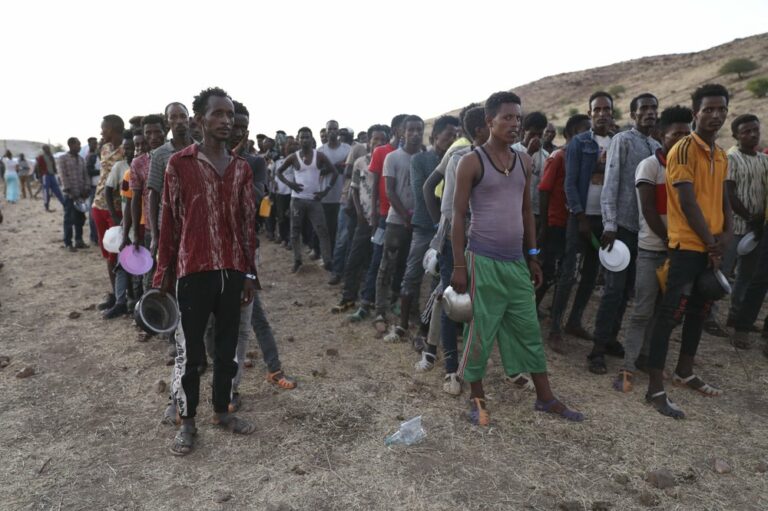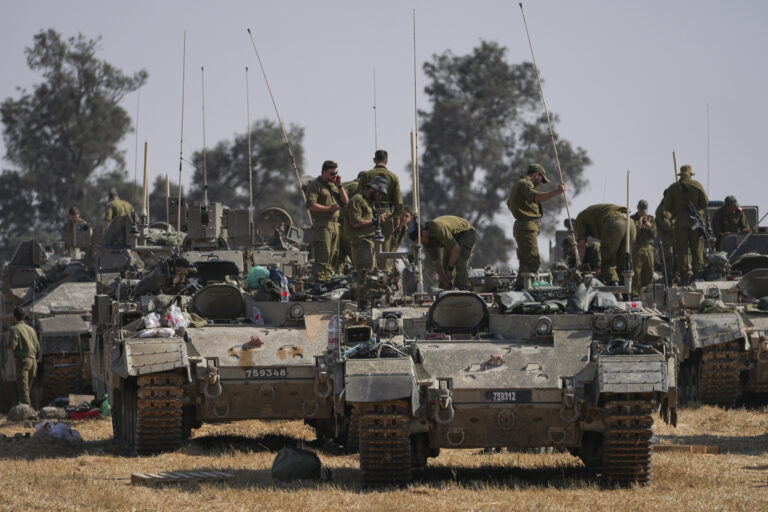People are going hungry in Ethiopia’s rebellious northern Tigray region as roads are blocked, airports are closed and the federal government marches on its capital in a final push to win a two-week war.
“At this stage there is simply very little left, even if you have money,” according to an internal assessment by one humanitarian group, seen by The Associated Press. The assessment, based on a colleague who managed to get out, said people “will stay where they are, there is no place in Tigray where the situation is any different and they cannot cross over into the other regions of Ethiopia because of fear of what would be done to them.”
They expect to be killed, the assessment said.
For more than a week, the United Nations and other aid organizations have been warning of disaster. Long lines formed outside shops within days of the Nov. 4 announcement by Ethiopia’s Nobel Peace Prize-winning Prime Minister Abiy Ahmed that a military offensive had begun in response to an attack by Tigray regional forces on a military base.
Trucks laden with food, fuel and medical supplies have been stuck outside the region’s borders. Banks in Tigray were closed for days, cutting off humanitarian cash transfers to some 1 million people. And even before the fighting, a locust outbreak had been destroying crops.
Over 27,000 Ethiopians have fled into neighboring Sudan, burdening villages that have been praised for their generosity, though they have little to give.
But many inside Tigray can’t or won’t leave, frightened by the threat of ethnic violence. Abiy’s office on Wednesday tried to ease those fears, saying in a statement that its “law enforcement operation” against a Tigray regional leadership it regards as illegal is “primarily” targeting members of that ruling circle.
“The people of Tigray will be the first to benefit” from the operation, the statement said, as senior government officials vow its completion within days. Abiy’s government accuses the Tigray regional government of damaging bridges and digging up roads leading to its capital, Mekele, in an attempt to slow the march of federal forces.
But Ethiopia’s federal government has been promising a rapid end to the fighting from nearly the start. And humanitarian groups, experts and even the United States government are showing signs of desperation.
“We do not know if there will be additional U.N.-coordinated relocation efforts out of Tigray,” the U.S. Embassy said in a brief statement Tuesday. “U.S. citizens who cannot depart Tigray safely are advised to shelter in place.”
Well over 1,000 citizens of the U.S. and other countries have been said to be trapped, along with the bulk of the Tigray region’s some 6 million residents, though the U.N. says more than 200 foreigners had been evacuated as of Tuesday. The Tigray regional government on Wednesday said more than 100,000 civilians have been displaced and called for urgent humanitarian assistance.
“Humanitarian workers should be given safe passage to provide assistance to vulnerable groups,” U.S. Secretary of State Mike Pompeo said in a statement overnight. “Communications services in the Tigray region should be restored immediately in part to allow independent reporting on the situation and to allow for communication with civilians, including U.S. nationals.”
U.N. humanitarian chief Mark Lowcock said in a separate statement, “I call for full access to reach people in need wherever they are; safe passage for civilians seeking assistance; and the security of aid workers.” Even before the conflict almost 1 million in the Tigray region needed humanitarian assistance, he said, along with millions more near its borders.
His office on Tuesday set aside $20 million “or anticipatory action to fight hunger in Ethiopia,” citing a long list of threats in the country, including “civil unrest, growing insecurity, locust infestations, and the economic fallout of the COVID-19 pandemic, which includes declining incomes and rising inflation.”
Even famine is a possibility in the Tigray region, researchers warn in a new article published by The Conversation, a website for researchers. Some 80% of the people in Tigray are subsistence farmers and the fighting affects the upcoming harvest season, they wrote.
And the locust outbreak, the region’s worst in decades, has “destroyed vast areas of cropped land and numerous swarms remain active in northeastern Ethiopia, where Tigray is located.”
The locust outbreak is so serious that even neighboring Eritrea, which has been almost silent on the conflict despite the Tigray forces firing rockets at it capital, speaks relatively openly about the insect invasion.
The split between Ethiopia’s federal government and Tigray’s — each now regards the other as illegal — has included the federal government’s move to divert funding from the regional government to local administrations, affecting early-warning systems for hunger, the researchers wrote.
This time of year was already the “hunger gap” for many, they said: “We fear that the grain baskets will remain empty because of the conflict.”
One of the researchers, Jan Nyssen, told the AP that “I know there are stores of the (U.N. World Food Program) inside Tigray, but they were there for a “normal disaster.”
Restocking such warehouses remains impossible, the U.N. said in a new update Wednesday.
Nyssen worries the locusts will end up posing the more severe threat. As of Nov. 3, the day before the fighting erupted, their swarms had reached as far as Mekele, he said, and they were expected to keep moving north, further into the region.
He also recalled the hunger that swept the Tigray region in the 1980s as its leaders fought the federal government. All the ingredients are here again, barring the locusts, he said. Back then, Ethiopia’s regime tried to hide the suffering, he said. “Nowadays, you can’t hide it that long.”
(AP)











